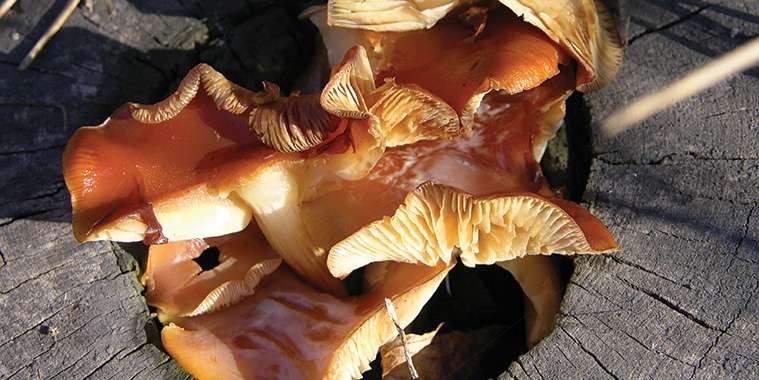By Dorothy Dobbie
While most of us eat button mushrooms commonly found in the grocery store, there are many other types to try for the true mushroom lover.
Chantarelles are greatly in favour. These are difficult to cultivate so they are growing scarce and hence are on the expensive side. Everyone knows about truffles, rooted out by pigs in woody areas of France, but what about chicken of the woods? This pretty two-toned mushroom can actually be used as a chicken substitute.
Cooking mushrooms for safety is a good idea, not only because it can remove mild toxins, but because mushroom cell walls contain indigestible chitins which are broken down by cooking.
Mushrooms come in all shapes and sizes, from ugly to beautiful to eerie.
Among the weirdos are the jelly mushrooms, often called tree ears, wood ears or jelly ears. These are the Auricularias and you will often find them in northern Chinese cuisine. They were also used medicinally in China to improve breathing, improve circulation and preserve long life.
The red spotted Amanita muscaria or fly agaric is said to have psychedelic effects if not carefully cooked. Back in the day, these mushrooms were dried, then powdered and sprinkled on milk as an insecticide. The yellow or white Amanitas are deadly.
Watch out for the blue mushrooms; although some are delicious when properly cooked, those that cause blue or black stains can also be poisonous.
Some people call the psilocybin mushrooms “magic mushrooms” because ingesting them produces symptoms that mimic those of low doses of marijuana. Regardless, these psychedelic mushrooms are now being taken more seriously by researchers who see in them hope for those who suffer from depression and anxiety. They are still studying the issue, though, because a minority of users can experience recurring hallucinogenic episodes and some have experiences that are the opposite of what is intended.
Even though less than one per cent of the world’s mushrooms are poisonous, those that are can be deadly so always err on the side of caution when testing mushrooms. Mushrooms grown in polluted areas can also pick up and transfer the pollution. And improperly stored or old mushrooms can make you ill. If they smell bad, are slimy, wrinkly or have dark spots, discard.
Roman aristocrats were extra vigilant when they ate mushrooms; they always had a mushroom taster on hand.
Dried mushrooms can keep for years. Wash and slice fresh mushrooms; the thinner the slice, the faster they dry. Place the slices on a paper towel and then in a 150 degree Fahrenheit oven for one hour, blot any moisture with a paper towel, turn over and bake for another hour or until they are completely dry. Store dried mushrooms in an airtight jar. You can also freeze dry them between layers of paper towel in a paper bag in your freezer.
Never store fresh mushroom in plastic bags, where they will quickly spoil. Use paper or leave them in the container they came in. Properly stored commercial mushrooms will keep four or five days.
Exposure to sunlight can manufacture vitamin D2 content in mushrooms; a three-ounce (85 gram) portion would provide about 400 IU of vitamin D. The CEO of Mushrooms Canada predicts that vitamin D-fortified mushrooms will soon be on the market. The interesting thing is that mushrooms don’t contain vitamin D to begin with. Instead they contain a plant sterol called erogosterol. It takes sunlight to move this sterol to the next step to turn it into vitamin D2. Sunlight-exposed mushrooms keep their vitamin D for up to a year — even when you dry them. Humans can also produce vitamin D with exposure to sunlight, in our case, it is vitamin D3.
By the way, puffballs are edible — at least the Giant Puffball (Calvatia gigantea) is. They grow east of the Rockies in meadows and in grassy areas, are shaped like a pear and have no differentiated cap. Watch out for deadly amanitas (the Destroying Angel) that are white but do have a cap and are slightly discoloured inside. When young, they are very good at imitating puffballs. To be sure you have a true puffball, cut it in half. The flesh should be hard and white, not brown, black, purple or yellow.
Dorothy Dobbie is the publisher of Manitoba Gardener magazine. Listen to her garden show on CJNU 92.7 FM every Sunday morning at 8.



